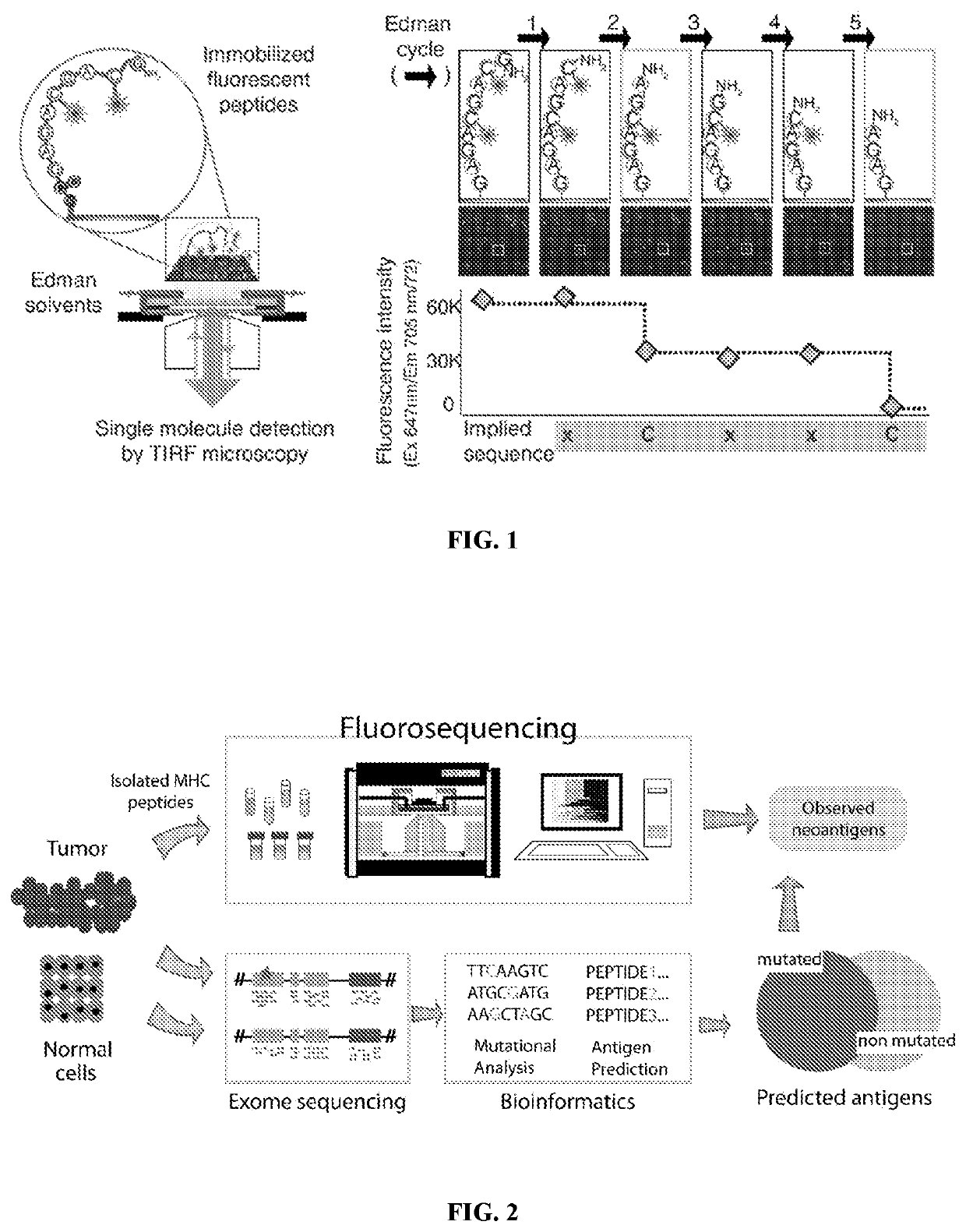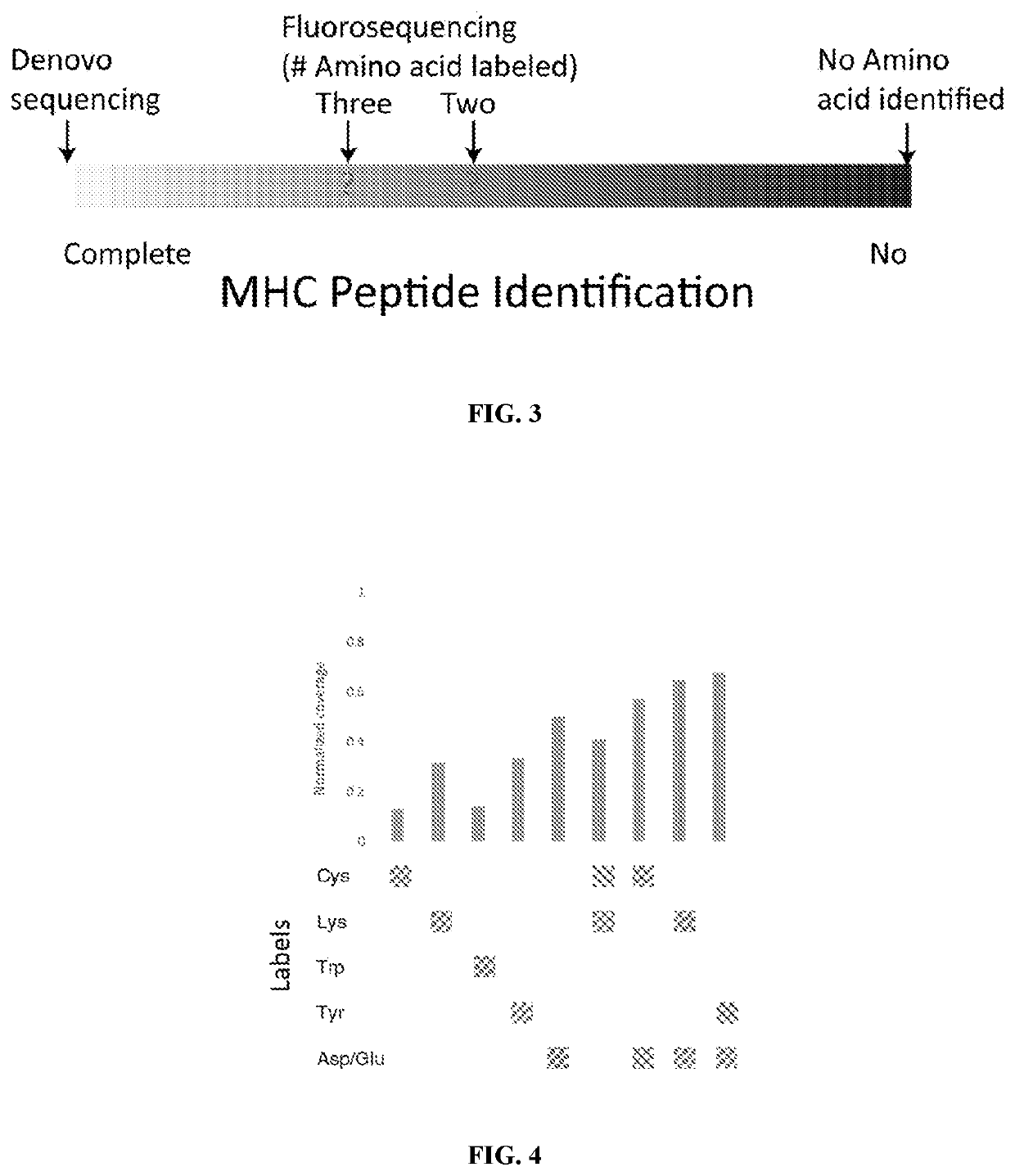Single molecule sequencing peptides bound to the major histocompatibility complex
- Summary
- Abstract
- Description
- Claims
- Application Information
AI Technical Summary
Benefits of technology
Problems solved by technology
Method used
Image
Examples
example 1
the Peptides Bound to the MHC by Identity and Quantity Through Sequencing
[0119]The methodology used for profiling MHC peptides is summarized in FIG. 2. Broadly, the process is subdivided into four parts: (a) procedures for extracting and enriching MHC bound peptides from biological samples, (b) labeling amino acids with fluorophores and performing fluorosequencing data, (c) performing genomic and transcriptome sequencing of the biological sample, and (d) integrating the fluorosequencing and genomic data with bioinformatics analysis to obtain a list of potential MHC peptide sequences. Each of these embodiments is set out in more detail below.
[0120]A. Extracting MHC Bound Peptides:
[0121]A number of methods for enriching and extracting MHC bound peptides have been well described in literature (Yadav et al., 2014; Müller et al., 2006). The cells and tissues are first lysed and the MHC proteins are enriched by immuno-precipitation method. Briefly, the MHC-I allele specific (or pan alleli...
example 2
onal Simulation of Fluorosequencing to Validate its Application for MHC Peptide Profiling
[0133]Fluorosequencing of MHC peptides for identification provides an information content of the sequence between two extremes as shown in a simple schematic in FIG. 3. On one end of the scale there is no information of the MHC peptides when none of the amino acids are labeled. On the other end of the scale, where all the amino acid identities are known, the MHC peptides can be fully identified. Partial amino acid labeling scheme by fluorosequencing lies in the middle of this information scale. In order to determine the position of fluorosequencing derived information on the scale, different labeling methods were simulated to determine the labeling strategy that maximizes information content and to validate its application as MHC peptide profiling tool.
[0134]The following two simulations study highlights the feasibility of fluorosequencing technology to access the information content in publicly...
example 3
g HLA Peptides
[0140](i) HLA Peptides from Mono-Allelic B-Cells
[0141]Pilot experiments were setup to obtain and validate HLA peptides and predict neo-antigenic peptide on a mono-allelic B-cell lines. The isolated peptides were sequenced by fluorosequencing and target peptide spiked into the mixture to determine limits of detection.
[0142](ii) Isolating and Validating HLA Peptides
[0143]Two mono-allelic B-cell lines (HLA-A2603 and HLA B0702 were purchased from The International Histocompatibility Working Group as detailed in the publication (Petersdorf et al., 2013). 3×108 cells were cultured and HLA peptide purification was performed as described (Abelin et al., 2017). A schematic of the process is shown in FIG. 6.
[0144]The isolated HLA peptides were identified by LC coupled tandem mass-spectrometer (ThermoFisher, Orbitrap Fusion Lumos) using a reference dataset of a human proteome (Swissprot) and with settings described in literature for analyzing HLA peptides (Abelin et al., 2017; Ba...
PUM
| Property | Measurement | Unit |
|---|---|---|
| Fluorescence | aaaaa | aaaaa |
| Affinity | aaaaa | aaaaa |
Abstract
Description
Claims
Application Information
 Login to view more
Login to view more - R&D Engineer
- R&D Manager
- IP Professional
- Industry Leading Data Capabilities
- Powerful AI technology
- Patent DNA Extraction
Browse by: Latest US Patents, China's latest patents, Technical Efficacy Thesaurus, Application Domain, Technology Topic.
© 2024 PatSnap. All rights reserved.Legal|Privacy policy|Modern Slavery Act Transparency Statement|Sitemap



